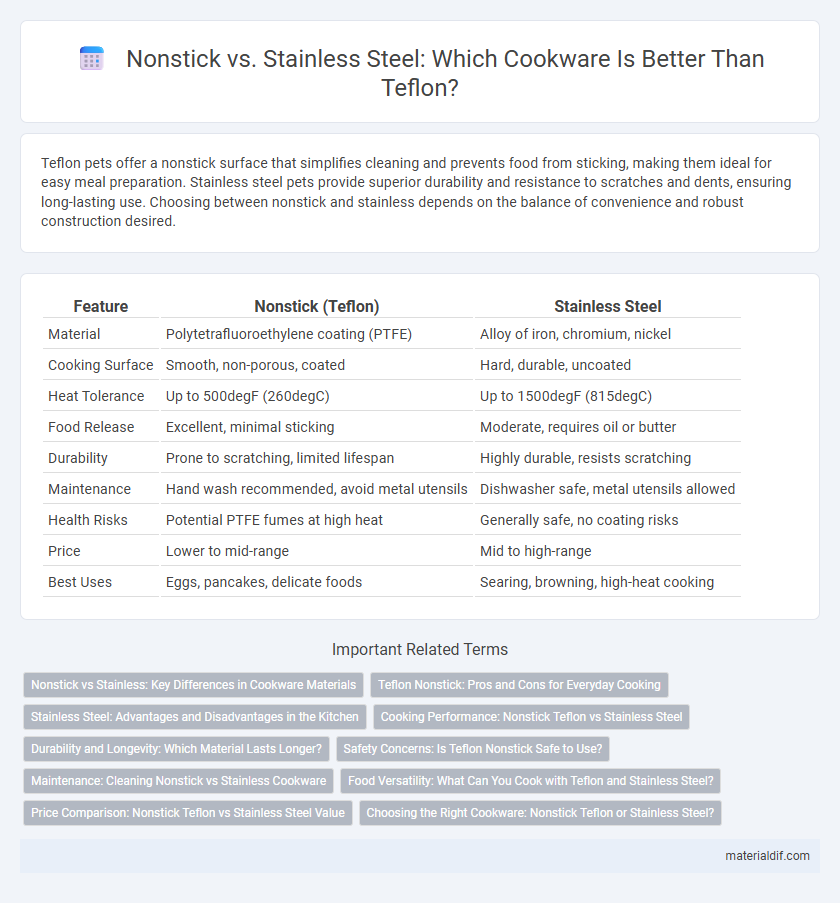Teflon pets offer a nonstick surface that simplifies cleaning and prevents food from sticking, making them ideal for easy meal preparation. Stainless steel pets provide superior durability and resistance to scratches and dents, ensuring long-lasting use. Choosing between nonstick and stainless depends on the balance of convenience and robust construction desired.
Table of Comparison
| Feature | Nonstick (Teflon) | Stainless Steel |
|---|---|---|
| Material | Polytetrafluoroethylene coating (PTFE) | Alloy of iron, chromium, nickel |
| Cooking Surface | Smooth, non-porous, coated | Hard, durable, uncoated |
| Heat Tolerance | Up to 500degF (260degC) | Up to 1500degF (815degC) |
| Food Release | Excellent, minimal sticking | Moderate, requires oil or butter |
| Durability | Prone to scratching, limited lifespan | Highly durable, resists scratching |
| Maintenance | Hand wash recommended, avoid metal utensils | Dishwasher safe, metal utensils allowed |
| Health Risks | Potential PTFE fumes at high heat | Generally safe, no coating risks |
| Price | Lower to mid-range | Mid to high-range |
| Best Uses | Eggs, pancakes, delicate foods | Searing, browning, high-heat cooking |
Nonstick vs Stainless: Key Differences in Cookware Materials
Nonstick cookware features a PTFE-based coating that prevents food from sticking and allows for easy cleaning, ideal for low to medium heat cooking. Stainless steel cookware is highly durable, non-reactive, and suitable for high heat, providing even heat distribution and excellent browning capabilities. Choosing between nonstick and stainless depends on cooking style, with nonstick excelling in delicate foods and stainless steel preferred for searing and deglazing.
Teflon Nonstick: Pros and Cons for Everyday Cooking
Teflon nonstick cookware offers exceptional ease of food release and quick cleanup, making it ideal for everyday cooking and low-fat meal preparation. However, Teflon surfaces can degrade at high temperatures, releasing harmful fumes if overheated, and the coating may wear off over time, reducing durability. Stainless steel cookware, while less slippery, provides superior heat retention and metal utensil resistance, making it a longer-lasting but less convenient option compared to Teflon nonstick.
Stainless Steel: Advantages and Disadvantages in the Kitchen
Stainless steel cookware offers exceptional durability and resistance to scratches, high temperatures, and corrosion, making it ideal for searing and deglazing. It does not have a nonstick coating, so food can stick if not properly preheated or oiled, requiring more attention during cooking. While stainless steel is dishwasher safe and maintains its shiny appearance over time, it can be more difficult to clean after cooking sticky or burnt food compared to Teflon-coated nonstick pans.
Cooking Performance: Nonstick Teflon vs Stainless Steel
Nonstick Teflon cookware delivers superior food release and requires less oil, making it ideal for delicate foods like eggs and fish, enhancing cooking ease and cleanup. Stainless steel excels in high-heat cooking and browning due to its excellent heat retention and even distribution, producing flavorful seared crusts. The choice between nonstick Teflon and stainless steel depends on desired cooking techniques and maintenance preferences, with Teflon favored for ease and stainless steel for professional-grade searing.
Durability and Longevity: Which Material Lasts Longer?
Stainless steel cookware offers superior durability and longevity compared to Teflon-coated nonstick pans, resisting scratches, dents, and warping over years of use. Teflon coatings tend to degrade and lose nonstick properties after several years, especially when exposed to high heat or abrasive utensils. For long-term investment, stainless steel maintains structural integrity and performance far beyond the typical lifespan of nonstick surfaces.
Safety Concerns: Is Teflon Nonstick Safe to Use?
Teflon nonstick cookware is generally considered safe when used under normal cooking temperatures, as it prevents food from sticking and requires less oil, promoting healthier meals. However, overheating Teflon above 500degF (260degC) can release harmful fumes, posing health risks, while stainless steel cookware lacks this risk and offers durability without chemical coatings. Users prioritizing safety might prefer stainless steel for high-heat cooking, but Teflon remains a convenient choice for low to medium heat applications when used properly.
Maintenance: Cleaning Nonstick vs Stainless Cookware
Nonstick cookware requires gentle cleaning with non-abrasive sponges to preserve the coating and prevent scratching, while stainless steel can withstand vigorous scrubbing and abrasive cleaners for tough residues. Stainless cookware often needs more effort to remove food stuck to the surface but can endure higher heat and harsh cleaning methods without damage. Proper maintenance for nonstick pans extends their lifespan by avoiding metal utensils and high-temperature washing, whereas stainless steel demands regular polishing to maintain its shine and prevent discoloration.
Food Versatility: What Can You Cook with Teflon and Stainless Steel?
Teflon-coated cookware excels in preparing delicate foods like eggs, pancakes, and fish without sticking, ideal for easy cleanup and low-fat cooking. Stainless steel pans handle high-heat searing and browning, perfect for steaks, stir-fries, and deglazing to create rich sauces. Combining both materials enhances kitchen versatility, allowing for a broader range of cooking techniques and dishes.
Price Comparison: Nonstick Teflon vs Stainless Steel Value
Nonstick Teflon cookware generally offers a lower initial price point compared to stainless steel, making it an affordable option for budget-conscious buyers. While stainless steel tends to have a higher upfront cost, its durability and long lifespan often provide better value over time, reducing the need for frequent replacement. Consumers should consider both the initial investment and long-term performance when comparing nonstick Teflon versus stainless steel cookware prices.
Choosing the Right Cookware: Nonstick Teflon or Stainless Steel?
Choosing between nonstick Teflon and stainless steel cookware depends on cooking style and maintenance preferences. Nonstick Teflon pans offer superior food release and easy cleanup, ideal for delicate foods and low-oil cooking, while stainless steel provides durability, high-heat tolerance, and better browning for searing and deglazing. Consider factors such as heat distribution, durability, and dishwasher safety to select cookware that best suits your kitchen needs.
Nonstick vs Stainless Infographic

 materialdif.com
materialdif.com